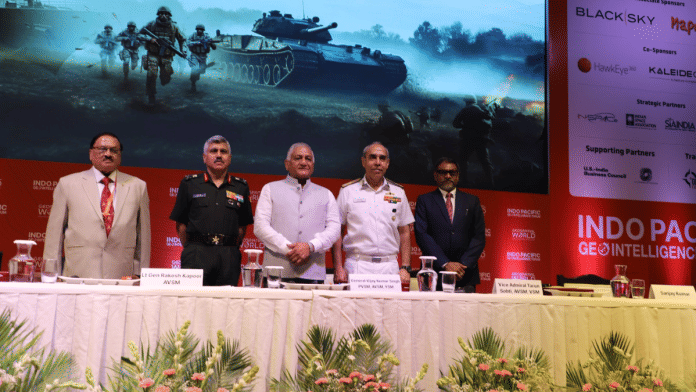New Delhi: Emphasising the importance of the Indo-Pacific, Deputy Chief of Army Staff (Information Systems and Coordination) Lt. Gen. Rakesh Kapoor has said that since the region is an economic powerhouse and home to nearly half of the world’s population, its militaries require geospatial technology to gain a competitive advantage over their adversaries.
Geospatial technology is used for the collection, storage and organising of geographic information.
“Indo-Pacific is a theatre of rivalries,” Lt. Gen. Kapoor said Tuesday at the 14th edition of Indo-Pacific Geo Intelligence Forum in New Delhi.
While he referred to land, sea, air and space domains as global commons for growth and development, Lt. Gen. Kapoor said the issue with these, however, was the lack of adherence to laws and governance.
Pointing out the paradoxes, he said the Indo-Pacific region was characterised by cooperation and collaboration but competition existed. He added that the region was marked by prosperity and progress, but poverty existed.
Over 35 percent of global cybercrimes occur within the confines of the Indo-Pacific. Existing threats such as human trafficking, illegal fishing, drugs and piracy were all on the rise, which was leading to the loss of lives, he added.
Lt. Gen. Kapoor said space is the new frontier and that it was now increasingly becoming a possibility with great power astropolitics. He emphasised the need for a mechanism to monitor everything and ensure that the geopolitical theories of British academic Halford Mackinder and American strategist Alfred Thayer Mahan didn’t extend to space.
Navy Vice-Admiral Tarun Sobti spoke about the vastness of the Indo-Pacific. “It stretches from the Gulf of Oman in the West to the Pacific coast of the US in the East and covers more than 70 million square kilometres. The Indo-Pacific region principally comprises the Indian and Pacific oceans. And therefore, I feel that the multidomain regional security of the Indo-Pacific has a very strong maritime component to it,” he said.
The Indo-Pacific region harbours around 40 countries — nearly 64 percent of the world’s population, nearly 50 percent of the world’s trade, while 90 percent of Indian trade close to the region is here which includes oil, container cargo and oil cargo, he added.
He said these statistics were an indicator of the fact that the maritime domain holds immense strategic, economic and cultural significance on the global stage.
“Statistics that concern me even more are about the recent maritime incidents which have been happening in the region. In 2023, the international fusion centre — IFC-IOR — monitored 3,955 incidents across the IOR (Indian Ocean Region) itself. There has been a significant rise in maritime security threats involving hybrid threats in the western Indian Ocean, which, of course, we attribute to the Hamas-Israel conflict.”
He said, recently, IFC-IOR noted that a significant increase in piracy and armed robbery incidents in the Gulf of Aden and the area east of Somalia has been on the rise. He said 800 Illegal, Unreported and Unregulated (IUU) incidents were recorded in 2023.
As for contraband smuggling, there was an upswing of 18 percent in 2023 compared to 2022. There were 243 incidents of illegal human migration in IOR. Maritime incidents, which comprise collusion, sinking, fire, search and rescue requirements, were the most frequently reported type of incidents — nearly 2000 incidents occurred in 2023.
He informed that as on date, there are 53 units from extra regional forces operating in the IOR itself, adding that these are regular warships with the majority of them from the US, European countries, China, Japan, and Korea.
According to Vice-Admiral Sobti, surveillance in this area is further complicated by the presence of dark shipping, a significant maritime traffic and limited assets vis a vis the vast area, specially from a few dozen miles from the coastline.
He said that the rapidly changing security landscape along with the vastness of this region makes seamless surveillance a prerequisite action. He added that the current mitigating measures being undertaken for surveillance include military assets, but the Navy also uses space-based surveillance assets.
Some of the modern trends in use are space-based surveillance and unmanned systems, he said.
“Continual surveillance has allowed nations to monitor vast expanse of maritime space and detect suspicious activities without requiring human presence in dangerous zones,” the Vice-Admiral said, adding that geospatial technologies and space infrastructure are the areas where India could expand its surveillance capabilities.
(Edited by Tony Rai)
Also Read: ‘Day not far when China coerces India with use of missiles,’ says Lt General PR Shankar (Retd)






